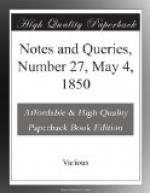JAMES T. HAMMACK.
April 2.
* * * * *
EARLY STATISTICS.—PARISH REGISTERS.
In reference to the observations of your correspondent “E.R.J.H.,” he will find, upon closer examination, that no comparison approaching to accuracy can be made between the population of any place at different periods of the seventeenth century, founded upon the entries in parish registers of baptisms, births, or marriages. In 1653 the ecclesiastical registers ceased to contain much of the information they had before given. In that year was passed, “An Act how Marriages shall be solemnised and registered, and also for a Register of Births and Burials;” which first introduced registers of births and not of baptisms. The Act treated marriage as a civil contract, to be solemnised before a justice of the peace; and it directed that, for the entry of all marriages, and “of all births of children, and burial of all sorts of people, within every parish,” the rated inhabitants should choose “an honest and able person to be called ‘The Parish Register,’” sworn before and approved by a neighbouring magistrate. Until after the Restoration, this Act was found practicable; and in many parishes these books (distinct from the clergyman’s register of baptisms, &c., celebrated in the church) continue to be fairly preserved. In such parishes, and in no others, a correct comparative estimate of the population may be formed.
The value of the parochial registers for statistical and historical purposes cannot be overrated; and yet their great loss in very recent times is beyond all doubt. It was given in evidence before the committee on registration, that out of seventy or eighty parishes for which Bridges made collections a century since, thirteen of the old registers have been lost, and three accidentally burnt. On a comparison of the dates of the Sussex registers, seen by Sir W. Burrell between 1770 and 1780, and of those returned as the earliest in the population returns of 1831, the old registers, in no less than twenty-nine parishes, had in the interval disappeared; whilst, during the same half-century, nineteen old registers had found their way back to the proper repository. On searching the MSS. in Skelton Castle, in Cleveland, a few years since, the first register of that parish was discovered, and has been restored.
These changes show how great the danger is to which the old registers are exposed; and in many instances it saves time and trouble to search the Bishop’s transcripts before searching the original registers.
WM. DURRANT COOPER.
81. Guildford Street, March 25. 1850.
* * * * *
BYRON’S LARA.




